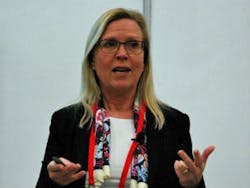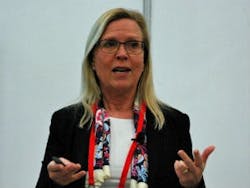“Correlate the data or apply machine-learning algorithms to predict outcomes.” ABB’s Matilda Steiner explained the second ingredient for smart operations at this week’s ABB Customer World in Houston.
Smart operations means doing less and getting more by leveraging technology, began Matilda Steiner, product line manager, ABB, in her presentation at ABB Customer World this week in Houston. She and her colleague Piotr Powroznik, technical product manager, explained the three ingredients needed to achieve smart operations using the ABB Ability Manufacturing Operations Management (MOM) software suite.
The three ingredients needed to achieve smart operations, Steiner said, are analytics, people and synchronization:
-
Data to supercharge continuous improvements, optimization and responsiveness;
-
Empowered knowledge workers to apply intelligence and human ingenuity; and,
-
Connectivity to synchronize and orchestrate the different entities that are involved.
Analytics are the first ingredient. “Analytics have different flavors,” explained Steiner. “Analytics unleash productivity. Identify where you have problems or variations, and then discover opportunities to avoid issues and capture hidden value. We want to aggregate and find best practices at the enterprise level. On the plant side, we want improvement through deeper insights into performance. And, at the line level, we can drill down even deeper.”
Start by collecting data and visualizing it in a dashboard. “What is new, compared to a few years ago?” asked Steiner. Once you can visualize that in the dashboard, then add more data and intelligence to discover previously unknown relationships between certain materials, assets or schedules, she said.
“Correlate the data or apply machine-learning algorithms to predict outcomes,” added Steiner. “Select the best batch—the golden batch—that you can compare with other batches. Compare parameters, durations and trend data across different batches. Find what factors contribute to making it the perfect batch. Then, we can answer questions we didn’t know to ask in the first place.”
Empowered knowledge workers
The second ingredient, people, is what’s needed to improve the processes. “This is where MOM comes into play,” said Steiner. “An empowered knowledge worker turns analytical insights into concrete plans of action. Then test, roll out and sustain.” Human error is the main contributor to primary and secondary plant incidents, she added.
“Mitigate those risks by making the right information available and empowering people to act. We can also introduce workflows to enforce operating procedures and continuously train and develop skills and awareness.” MOM includes a Virtual Trainer that can be used to train these people.
Orchestration and synchronization comprise the third ingredient for smart operations. “Comprehensive workflow ensures consistent order execution,” explained Steiner. “Virtual representation of the physical execution combined with utilization of mobile technology introduces efficiencies and new error-reducing measures.”
The MOM software suite coordinates and synchronizes procedures to increase efficiency and traceability. When an order comes down, for example, MOM tells the robot to pick up a part and take it to the next step. “Sometimes it’s the orchestration of the robotics, and sometimes it’s also the traceability,” explained Steiner.
The new release of Manufacturing Operations Management creates a new user experience for operations management applications, said Powroznik. “The new web-client framework is a responsive design with great functionality,” he explained. “You link it with the cloud in a granular way.”
With the new release, integrated process-historian and MES (manufacturing execution system) apps are available in one portfolio, enabling data aggregation and correlation. “Apps are designed for self-service and collaboration,” said Powroznik. “And no IT knowledge is required to prepare your workplace.”
Data can be stored and analyzed on-prem, in the cloud or in a hybrid configuration. “The new MOM framework improves client usability and user experience. There’s a new common web-client framework across all MOM applications. It’s available on Windows, iOS and Android, and there’s support for Edge, Chrome and Safari. You can take your notifications with you on you mobile device.”
“You can bring live data from the historian and the process to live, mobile dashboards,” said Powroznik. “There are many other dashboards, but none of them can bring in historian data together with operational data.”
Using machine and sensor data with MOM/MES data, information becomes insight for reporting and analytics. “You can find answers to all sorts of questions having to do with capacity utilization, OEE, mean time between failure, cycle time, load vs. capacity and production traceability,” explained Powroznik.
About the Author
Mike Bacidore
Mike Bacidore

Leaders relevant to this article:

